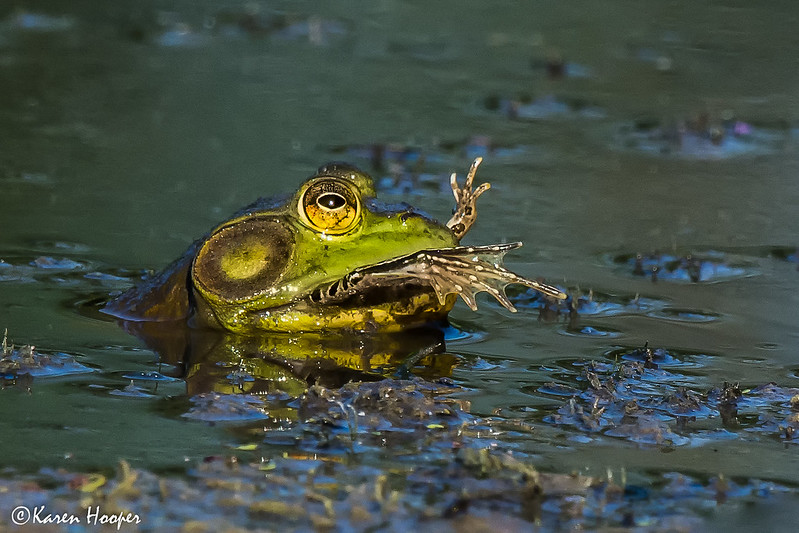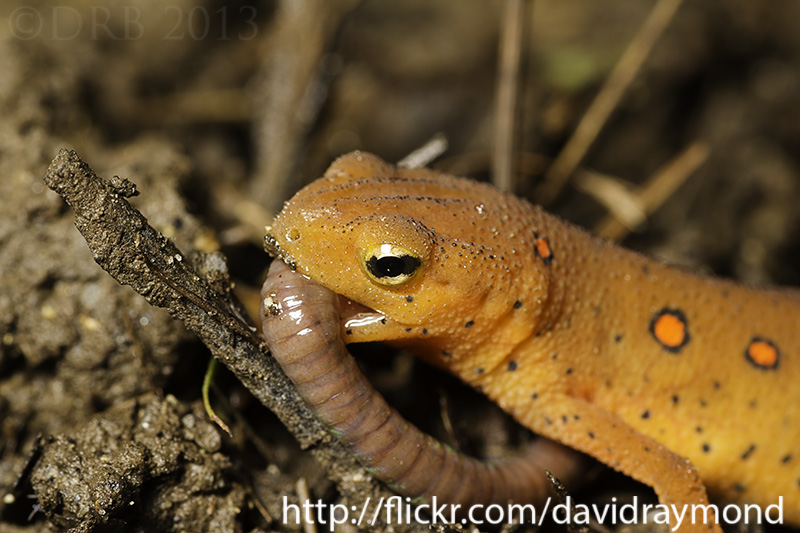Views:
People like watching animals eat. That’s the first thing I learned after I started doing live feeding demonstrations for the public at a local science center with a collection of native frogs and salamanders. In those demonstrations, nightcrawlers and crickets were the only items on the menu, but people wanted to know what amphibians eat in the wild too. One young child timed her question perfectly; no sooner than she had finished asking me what a bullfrog would eat in a pond, she placed her hand against the exhibit glass and a massive bullfrog lunged, mouth open, right for her hand. What do frogs and salamanders eat? They eat anything that moves that they think will fit in their mouth.
Frogs and salamanders are what’s known as “gape-limited predators”, which is a fancy way of saying the size of their mouth is the biggest factor behind what they will eat. Quite often, that leads to frogs attempting to eat things that aren’t actually edible in any way, shape, or form. As a kid, I spent countless hours fishing in a Lake Champlain bay near my house, and as I reeled my line in it was pretty common to watch bullfrogs chase after my plastic bobbers. A few times I even managed to “land” the frogs when they refused to let go of their round plastic bounty.
Just about anything is on the menu for a frog and salamander, even their own kind, and cannibalism is VERY common among amphibians. This is very well documented in frogs, especially the American Bullfrog, which has zero hesitation in eating smaller bullfrogs. In some studies, over half of the stomach contents of bullfrogs were smaller frogs, most of which were juvenile bullfrogs. From a nutritional standpoint, cannibalism makes a lot of sense – it’s like walking into a grocery store and finding an abandoned cart filled to the top with everything on your shopping list.

Cannibalism isn’t as well-documented in salamanders, though, which are much more difficult to observe feeding in the wild compared to frogs. Red Salamanders, Spring Salamanders, Spotted Salamanders, and Blue-spotted Salamanders are just a few examples where cannibalism is well-known, and my takeaway after combing through the literature about salamander diets is that if a salamander species is studied closely enough, sooner or later cannibalism is documented.
In the case of bullfrogs, there doesn’t seem to be an end to the list of things they will try to eat, and some people have even seen bullfrogs eating chipmunks and juvenile weasels. While bullfrogs are frequently eaten by snakes, snakes are also eaten by bullfrogs. In parts of the world where bullfrogs are invasive, their seemingly unending appetites for local wildlife is threatening native species. Bullfrogs do sometimes bite off more than they can chew, however, and if a glass pane hadn’t separated the young girl from the bullfrog at the science center, that would have been a good example.

That all said, different species of frog and salamander do specialize in feeding on different kinds of prey. Red-backed Salamanders favor termites but will settle for ants or anything else small and wriggly. Leopard Frogs feed mostly on insects, as do Wood Frogs. Mudpuppies, which are large aquatic salamanders found in much of the eastern United States, have powerful crushing jaws, and crayfish the size of their own heads are easy prey. When I was a technician in a Mudpuppy study, our most frequent catch was crayfish, but when we did catch Mudpuppies, it was very common for us to find nothing in the trap except the Mudpuppy and a pair or two of crayfish claws, absent the crayfish they previously belonged to.
The diets of frogs and salamanders can impact what species are found and where. For example, Mink Frogs are often less abundant or absent from wetlands with bullfrogs, and two theories explaining why are that bullfrogs either outcompete Mink Frogs for food, or they are just too good at catching and eating the Mink Frogs themselves. There is also concern that salamander populations may decline in response to drops in insect abundance and diversity within streams. Although many amphibians have variable diets and will consume whatever prey species are locally abundant, changes to the food web caused by human activity are a factor that may stress amphibian populations, which are already in decline for a variety of other reasons. However, wherever a frog or salamander is found, they are a force to be reckonned with for any animal smaller than their head. While part of me wishes the world had croc-sized amphibians, we should probably be thankful there aren’t any around with mouths wide enough to engulf people.



